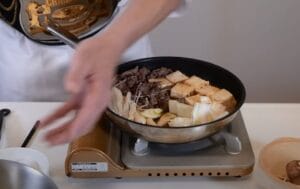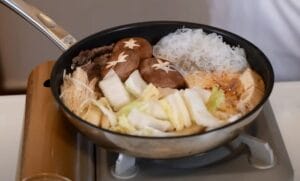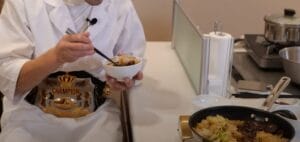As a food blogger at Food And Meal, I’m always eager to dive deeper into global cuisines to discover new flavor profiles. During a recent exploration of Japanese cooking, I came across an intriguing dish called Japanese Beef Sukiyaki Hot Pot.
Intrigued by its complex sweet and savory aromas, my mind raced with memories of visiting bustling Tokyo restaurants with communal hot pots bubbling away at every table. I fondly recalled the incredibly tender, melt-in-your-mouth beef paired with crisp vegetables and chewy noodles, all enveloped in a moreish broth that left me craving for more.
Eager to recreate that wonderful experience myself, I carefully gathered the necessary ingredients – thinly sliced beef, fresh vegetables, noodles, and the sweet soy-based warishita sukiyaki sauce. As the pot came up to a gentle simmer, the kitchen filled with the most enticing smells promising something magical.
When ready, I dipped my chopsticks into the pot to fish out some beef and vegetables glistening in the rich sauce. As I took my first bite, an explosion of sweet and savory flavors mingled beautifully across my palate – just like my food memories from Japan!
I can’t wait for you to gather friends and family around this wonderful Japanese Beef Sukiyaki Hot Pot. Now if you’ll excuse me, I need to dip my bowl back in for more of that delectable beef!
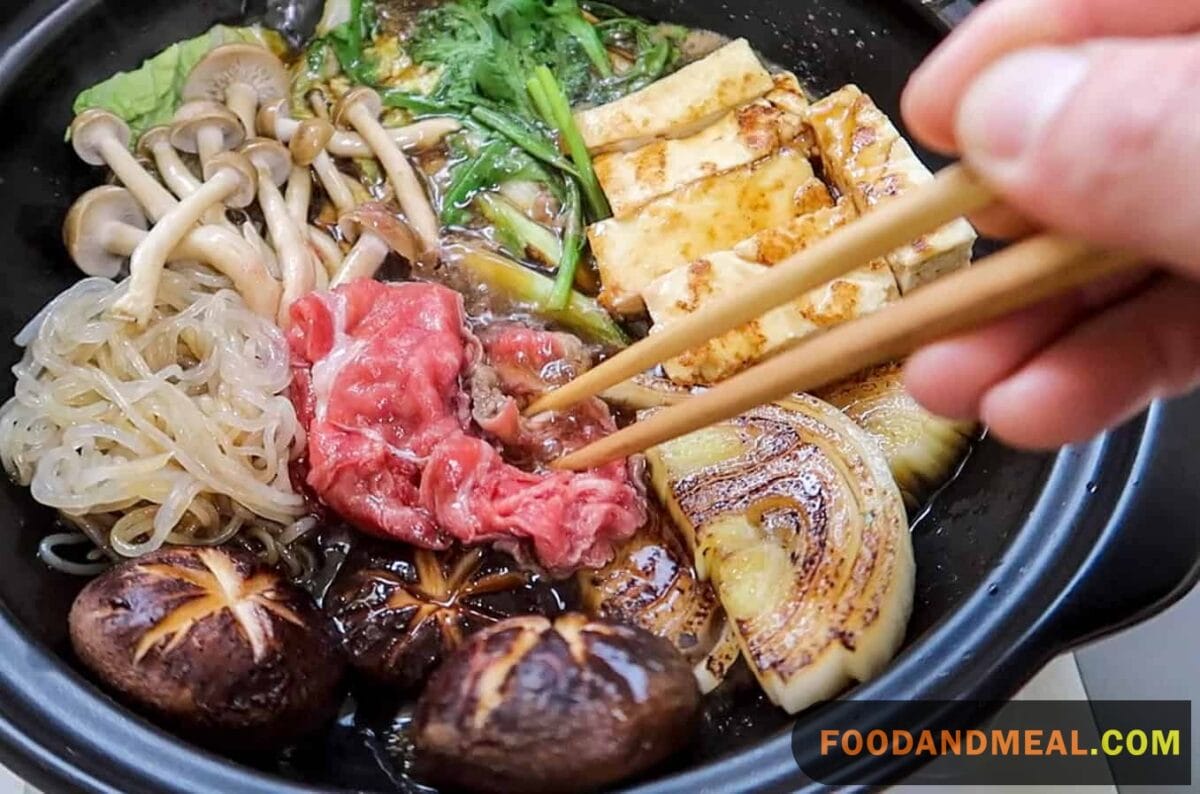
Beef Sukiyaki Hot Pot
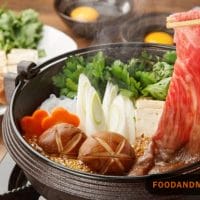
Japanese Beef Sukiyaki Hot Pot
Ingredients
- 1 tablespoon trimmings, beef fat
- 1 pound sliced rib eye or beef strip loin
- 8 to 10 shallots
- 1⁄2 pound cabbage
- 4 slices green onions
- 4 ounces shiitake mushrooms
- 7 ounces trimmed, separated mushrooms
- 6 ounces stick-cut tofu, broiled
- 2 cups sake
- 1/3 cup sugar
- 1/2 cup soy sauce, Japanese
- 1 cup Arugula leaves
- Short grain rice, cooked, for extra broth
Instructions
- Warm large pot on med. heat. Add the fat trimmings. Render the fat for about a minute. Add the sliced beef. Lay slices on platters.

- Arrange the noodles, tofu, mushrooms, green onions, cabbage and shallots in neat groups in pot. Add the soy sauce, sake and sugar. Simmer for 8-10 minutes.

- Add the arugula leaves atop the rest. Cook for one more minute. Serve in the same pot. Allow diners to help themselves to the meat slices, cooking them by dipping them in the hot broth.

- Eat pot goodies and then pour what is left into bowls of rice so the tasty broth can be finished, too.

Video
Notes
- Variations in Broth: While traditional sukiyaki broth harmoniously blends sake, mirin, and soy sauce, feel free to adjust the ratios to suit your taste preferences.
- Choosing Appropriate Beef Cuts: The quality of beef is paramount. Opt for ribeye or thinly sliced sirloin for a melt-in-your-mouth experience.
Nutrition
© Food And Meal
This website provides approximate nutrition information for convenience and as a courtesy only. Nutrition data is gathered primarily from the Spoonacular Database, whenever available, or otherwise other online calculators.
Beef Sukiyaki Hot Pot in a Pressure Cooker
Beef Sukiyaki has always been a communal dish, full of warmth and memories. The traditional way of making it is by simmering it slowly in a pot. But with the hustle and bustle of modern life, sometimes we need a quicker yet equally delicious solution. Enter the pressure cooker – a modern kitchen marvel that retains the integrity and flavors of this classic dish but cuts down the cooking time significantly. Here’s how to make Beef Sukiyaki Hot Pot using a pressure cooker:
Prepare all vegetables, ensuring beef is thinly sliced. Whisk soy sauce, sugar, mirin, and sake for the broth. In a pressure cooker, sear beef, then add tofu, mushrooms, cabbage, udon noodles, and green onions. Pour in broth mixture and dashi or beef stock. Seal, cook on high pressure for 10 minutes, release pressure safely. Stir, adjust seasoning, and serve hot in bowls. Enjoy with steamed rice or as is.
Cooking Tips
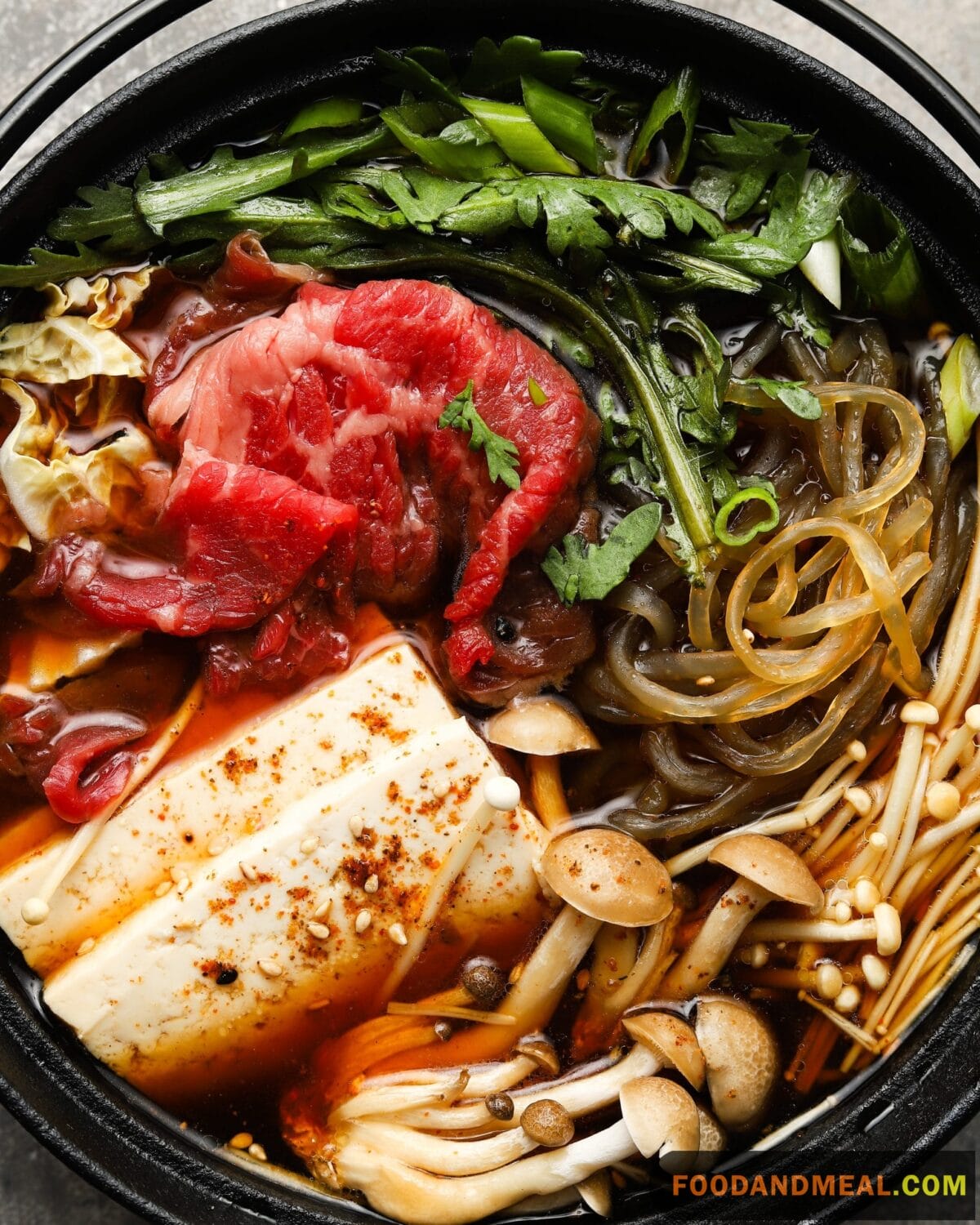
I fondly remember my overeager first try, when I carelessly added all the ingredients to the pot at once without considering cooking times. Impatient to taste the results, I ended up with extremely overcooked beef alongside completely raw vegetables. As I sadly stared at the inedible contents of my pot, I realized I needed patience when dealing with such varied ingredients.
My second attempt came after more careful research on proper sukiyaki technique. I gently simmered the vegetables first before adding the thin slices of beef at the last minute to briefly cook in the broth. This batch rewarded me with tender protein and crisp-tender veggies in an incredible sweet and savory sauce. Finally success!
I’ve now made this wonderful Japanese Beef Sukiyaki Hot Pot many times, and have learned to embrace the method’s need for awareness and focus. Respect the ingredients, consider the cooking times, then delight in gathering friends and family around the table to share in the interactive dining experience that sukiyaki offers.
Serving Suggestions
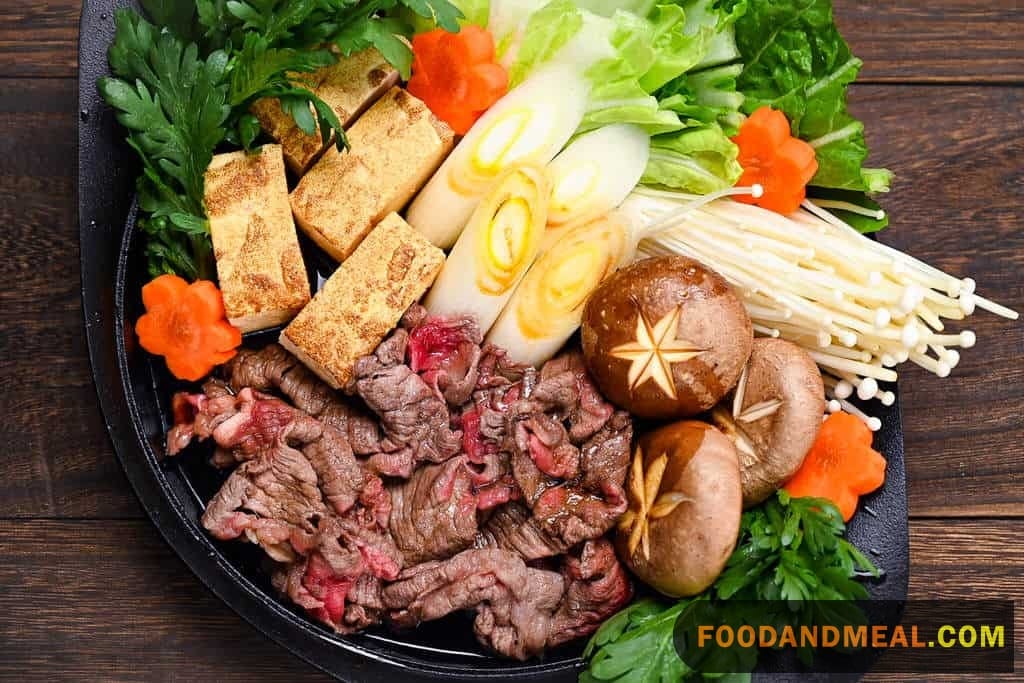
For heartier pairings, serve the hot pot with udon noodles, somen noodles, or Japanese Mazesoba noodles. Let guests scoop the tender beef and vegetables over their noodles along with ladles of the incredible broth.
You could also offer the sukiyaki hot pot as the star of a Japanese-inspired tapas spread. Serve bites of Norimaki Mochi, Tofu Hiyayakko, and Shrimp Tempura alongside, allowing guests to customize their dipping experience.
However you offer it, this Japanese Beef Sukiyaki Hot Pot makes for some cozy, interactive dining that brings people together. Gather friends and family around this wonderful dish!
List of 6 FAQs of Beef Sukiyaki Hot Pot
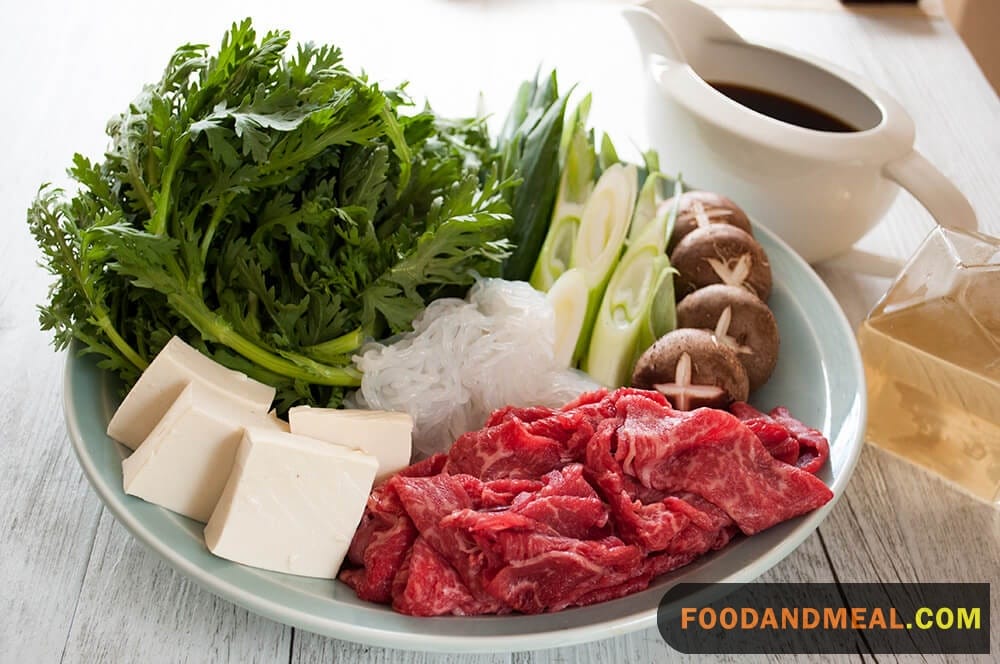
- Is sukiyaki the same as hot pot? No, they are different. Sukiyaki is a Japanese hot pot dish cooked at the table, while hot pot refers to a broader category of Asian communal cooking where ingredients are cooked in a shared pot of simmering broth.
- What is beef sukiyaki made of? Beef sukiyaki typically includes thinly sliced beef, tofu, mushrooms, cabbage, and other vegetables, cooked in a sweet and savory soy-based broth.
- What is the difference between shabu shabu and sukiyaki beef? Shabu shabu involves dipping thinly sliced beef briefly into hot broth, while sukiyaki beef is simmered in a sweet and savory soy-based broth with various vegetables.
- What are 3 popular Japanese hotpot dishes? Three popular Japanese hotpot dishes are Sukiyaki, Shabu Shabu, and Yosenabe.
- Can I use other types of meat for this hot pot? Absolutely! While beef is traditional, you can use thinly sliced chicken, pork, or even seafood. Just adjust the cooking time accordingly.
- What if I can’t find mirin or sake? If you can’t source mirin, a combination of white wine and a little sugar can be an alternative. For sake, dry sherry or Chinese rice wine are good substitutes.
- The broth tastes too strong. How can I adjust it? If the broth feels overpowering, consider adding more dashi or beef stock to dilute. Adjust seasoning accordingly.
- How do I store leftovers? Leftover Beef Sukiyaki Hot Pot can be stored in an airtight container in the refrigerator for up to 2 days. Before reheating, give it a good stir and ensure it’s heated thoroughly.
- Can I make this vegetarian? Yes! Replace beef with tofu or a meat substitute. Swap the beef stock with vegetable or mushroom stock. Add more veggies like bok choy, bell peppers, and baby corn for added texture and flavor.
-
Can the Recommended Rice Cookers from Japan Help in Making Authentic Japanese Beef Sukiyaki Hot Pot?Can the best Japanese rice cookers help in making authentic Japanese Beef Sukiyaki Hot Pot? With their advanced technology and precise temperature control, these rice cookers ensure perfectly cooked rice, a key component of Sukiyaki. Moreover, some models come with additional features like slow-cooking settings, perfect for simmering the flavorful ingredients of this traditional hot pot dish. Upgrade your cooking experience with these recommended rice cookers from Japan.
Conclusion
I hope you’ll take the time to make your own batch of this versatile Japanese Beef Sukiyaki Hot Pot. As I learned firsthand, a little patience and care goes a long way towards creating an incredible flavor enhancer for all types of dishes.
Be sure to visit Food And Meal at foodandmeal.com for the full, step-by-step recipe along with more inspirations for Japanese home cooking. Let us know how your Shio Tare turns out by leaving a comment below or tagging @foodandmeal on social media.
Happy cooking! I’ll be putting my latest batch of sauce to good use in a hot pot this weekend.
Hi! I'm Nazia of ‘Nazia Cooks’, a self-taught baker and cook residing in Chennai. Rooted in the rich South Indian culinary landscape, my palate has expanded to embrace global flavors. I revel in crafting fusion dishes, melding traditions to birth unique tastes.




